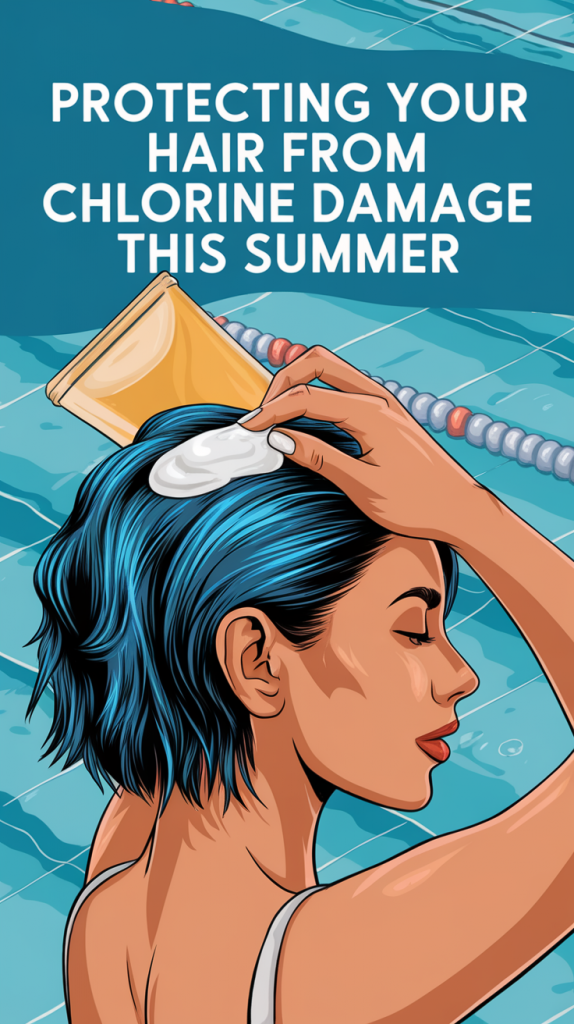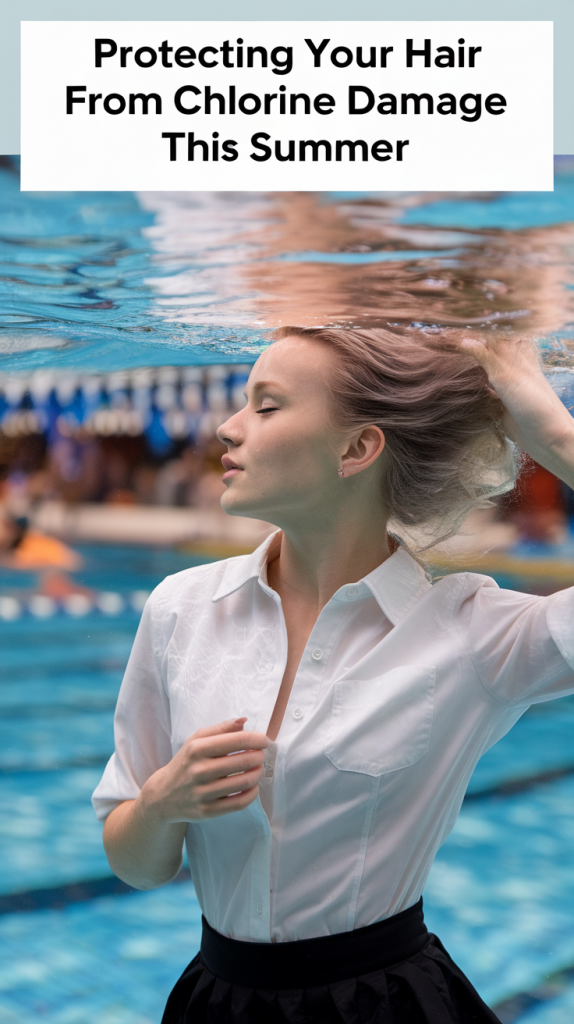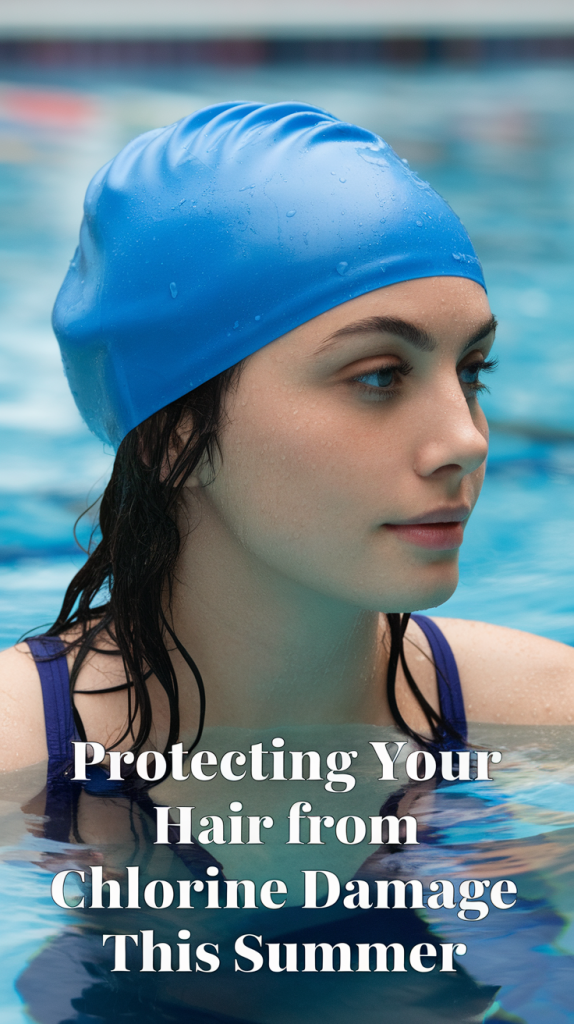How to Protect Your Hair from Chlorine: Science-Backed Tips for Summer 2025
Your hair loses approximately 80% of its natural oil reserves after a single exposure to chlorine swimming pools. Sitting at the pool or swimming under sunlight exposure leads to dry, damaged hair, which becomes brittle. The protection of your hair from chlorine damage proves simpler than most people expect.
This article presents scientific methods to protect your hair during swimming time. The article will explain swimming preparation techniques and post-swim care together with discussed product selections and natural solutions to maintain your hair’s hydration during the entire summer.
Who is this article for?
- Users of chlorinated swimming pools engage in regular pool usage.
- Users with colored hair together with dry and curly hair types.
- Parents need protective hair options prior to the summer season for their children.

Why Is Chlorine Harmful to Hair?
The Science Behind Chlorine and Hair Damage
Swimming pools receive protection against dangerous bacteria through chemical disinfection provided by chlorine. When chlorine touches hair, it deprives the cuticle of the protective natural oils. Over time, this leads to:
- Chlorine extraction of water molecules creates hair that breaks more easily due to its dry and brittle state.
- The interaction of chlorine with hair causes it to discolor light hair purple, and it will also cause fading effects on color-treated hairstyles.
- The penetration of chlorine inside hair shafts damages keratin bonds, thus creating conditions for hair breakage through split ends.
Who Is Most at Risk?
Multiple hair characteristics and health states make people more prone to chlorine-related damage.
- Blonde hair, together with colored hair, has a high susceptibility to color changes coupled with fading.
- Curly and Coarse Hair: Naturally drier and more vulnerable to moisture loss.
- Human hair on children remains fragile to chemical aggressors that cause damage readily.
How to Protect Your Hair Before Swimming
1. Rinse Your Hair with Clean Water
The technique succeeds because wet hair absorbs reduced amounts of chlorinated water because it has reached saturation with clean water. The absorption process of chlorinated water decreases by this method.
You should apply water at lukewarm or cool temperatures because this has better absorbing effects while helping your cuticle to shut.
2. Apply a Protective Barrier
The application of leave-in conditioners along with coconut oil or silicone-based serums will establish a protective layer that prevents chlorine from reaching your hair.
Best Products to Use:
- Leave-in conditioner with UV protection.
- Argan or coconut oil for natural hydration.
- Silicone-based sprays for a waterproof shield.
3. Wear a Swim Cap
The waterproof quality of swim caps does not reach total protection but still minimizes chlorine contact.
Recommended Materials:
- Silicone caps serve as durable swim caps that deliver an improved and tight closure system.
- Qualitatively, latex caps match well with leisure swimming.

What to Do During Swimming to Minimize Damage
1. Keep Your Hair Tied Up
Fans who have lengthy hair should secure their tresses because this practice decreases their exposure to chlorine molecules. Braiding the hair or creating a bun-style reduces both water absorption and ensures hair remains tightly packed.
2. Avoid Excessive Water Immersion
Maintain your hair submerged in chlorinated water only during short periods. Swimmers need to interrupt their time in the water to let their hair dry partially before returning for another swim session.
Best Post-Swim Hair Care Routine
1. Rinse Immediately After Swimming
Immediately rinse your hair with lukewarm clean water following swimming in order to remove chlorine, which must not reach the hair cuticles. Direct exposure to chlorine can cause permanent damage to hair, but rinsing with cool water stops this process before it becomes a problem.
2. Use a Clarifying Shampoo
The importance of using this shampoo stems from its ability to eliminate chlorine deposits on hair strands. Excessive use of this product leads to the removal of essential oils from your hair; therefore, perform it no more than once per week.
Top Picks:
- Paul Mitchell Clarifying Shampoo Three: Removes chlorine effectively.
- Olaplex No. 4C Bond Maintenance Clarifying Shampoo: Ideal for color-treated hair.
3. Deep Condition Regularly
After using deep conditioning masks, your hair will receive moisture sustenance, and natural softness will return. Hydrating ingredients such as argan oil, shea butter, and keratin are things to search for when choosing hair products.
Best Products to Protect Your Hair from Chlorine
| Product Type | Recommended Brands | Key Benefits |
|---|---|---|
| Clarifying Shampoo | Paul Mitchell, Olaplex | Removes chlorine buildup |
| Leave-in Conditioner | It’s a 10, Ouidad | Provides moisture barrier |
| Swim Cap | Speedo, TYR | Reduces water exposure |
| Coconut/Argan Oil | Moroccanoil, OGX | Adds protective barrier |
Natural Remedies to Combat Chlorine Damage
1. DIY Apple Cider Vinegar Rinse
The effectiveness of this method arises from apple cider vinegar, which helps restore hair pH balance, close the cuticles, and eliminate chlorine residue.
How to Use:
- Apply a mixture of one part apple cider vinegar along with three parts of water.
- Dilute the mixture before using it post-shampooing, then wash it out with cold water.
2. Aloe Vera and Coconut Oil Mask
Why it works: Aloe vera hydrates the scalp while coconut oil nourishes and repairs damaged strands.
How to Use:
- Mix equal parts aloe vera gel and coconut oil.
- Apply generously to damp hair.
- Leave on for 30 minutes before rinsing.

Common Mistakes to Avoid
1. Skipping Pre-Swim Protection
Lack of hair rinsing or protective product application sets you at higher risk for chlorine absorption, which causes gradual damage throughout time.
2. Using Hot Water Post-Swim
Application of hot water on the cuticles helps chlorine penetration because it makes the cuticles more accessible. People should use cool or lukewarm water to flush out their hair and scalp after swimming.
3. Overusing Clarifying Shampoos
Excessive use of clarifying shampoos will remove chlorine buildup from your hair, but it also removes essential natural oils that cause your hair to become dry.
Pro Tips for Different Hair Types
For Color-Treated Hair
- You should use sulfate-free shampoos in order to prevent color fading.
- Swimmers should use leave-in products designed for color protection immediately before entering the water.
For Curly and Coarse Hair
- Choose castor oil for sealing in moisture due to its thickness.
- Deep conditioning treatments should be applied twice per week to prevent dehydration.
For Fine or Straight Hair
- Use lightweight, non-greasy leave-in products.
- Heavy, weight-harming oils should be avoided for hair care.
How to Maintain Healthy Hair Throughout Summer
1. Hydrate, Hydrate, Hydrate
Your hair needs sufficient water consumption to stay hydrated at both a bodily level and a hair level. Damage to hair along with breakage happens frequently when hair becomes dehydrated.
2. Protect Your Hair from the Sun
Apply UV-protectant sprays together with wearing wide-brimmed hats to protect your hair because sun damage makes chlorine inflict more harm on your locks.
3. Trim Split Ends Regularly
Regular trimming of your hair every 6 to 8 weeks helps remove split ends while delivering better hair appearance.
FAQs: Everything You Need to Know About Chlorine and Hair
How often should I use a clarifying shampoo after swimming?
A clarifying shampoo should be used weekly because it clears product residue while safeguarding essential hair oils.
Can coconut oil really protect my hair from chlorine?
Yes! Coconut oil develops a barrier that blocks chlorine from reaching the hair shaft.
Is wearing a swim cap enough to protect my hair?
Swim caps decrease chlorine contact with the hair, but they cannot stop all water penetration. The best way to protect against chlorine exposure is to use both a swim cap together with a leave-in conditioner.
Conclusion: Key Takeaways to Keep Your Hair Healthy This Summer
- Priority of Prevention Requires a Precautionary Rinse and Protective Product Application before Swimming.
- You should rinse off immediately after swimming, followed by proper use of clarifying shampoos in case of need.
- Keeping hair well-hydrated with appropriate conditioners can stop the development of brittleness.
- Pre-swim safeguards and post-swim hot water use must both be avoided at all times.

